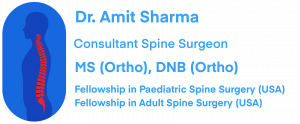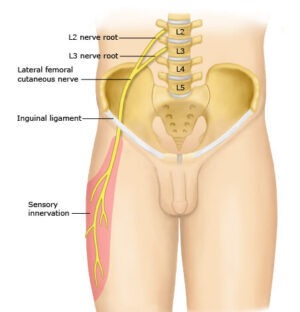Best Spine Surgeon in Mumbai | Dr. Amit Sharma

+91-9967600461
draks777@gmail.com
Meralgia Paresthetica: Symptoms, diagnosis and treatment

Meralgia Paresthetica: Symptoms, diagnosis and treatment
Meralgia Paresthetica
Meralgia Paresthetica is a condition in which patient feel tingling, numbness and sometimes pain on the front and outer side of the thigh area. Meralgia Paresthetica is secondary to compression or irritation of Lateral Femoral Cutaneous Nerve (LFCN) in the groin area. This nerve supplies sensation to antero-lateral aspect of the thigh. Nerve gets compressed while passing through or under the Inguinal ligament, a broad structure spanning anterior superior iliac spine (hard pointed, structure at the very top of thigh on outer aspect) to pubis bone.
Common Causes:
Tight and heavy clothing, obesity, recent significant weight loss, pregnancy are common causes of Meralgia Paresthetica. An injury to local area can also irritate the nerve. Diabetics are more prone to develop these symptoms.
Symptoms and Diagnosis:
Meralgia Paresthetica cases various sensory symptoms, e.g. pain, burning sensation, numbness, on the antero-lateral part of the affected thigh. A history of typical symptoms are the first clue to the diagnosis. Nerve block by local anesthetic injection near the site of origin causes reduction in symptoms and this acts as a confirmatory test.
EMG-NCV: This is definitive test which shows affection of the LFCN and rules out spinal nerve involvement, which can mimic similar symptoms, especially in higher lumbar spine disc involvement (e.g. D12-L1, L1-L2 or L2-L3).
MRI: An MRI is usually done to rule out a prolapsed disc which can cause similar symptoms.
Treatment:
Patients should try to remove high risk factors like obesity. Wearing loose clothes and light weight belt help relieve the symptoms.
Initial treatment of Meralgia Paresthetica is by medicines and physiotherapy. Trans-cutaneous electrical nerve stimulation (TENS) usually give significant relief. Nerve stabilizer medicines (pregabalin, gabapentin, nortriptyline etc.)improve patient symptoms. In patients who do not respond to medical treatment, a local steroid injection under inguinal ligament near the site of the origin of Lateral Femoral Cutaneous Nerve can be given to reduce inflammation around the nerve. Occasionally, surgical release of the nerve is required for the patients with severe symptoms and those who do not respond to above treatments.